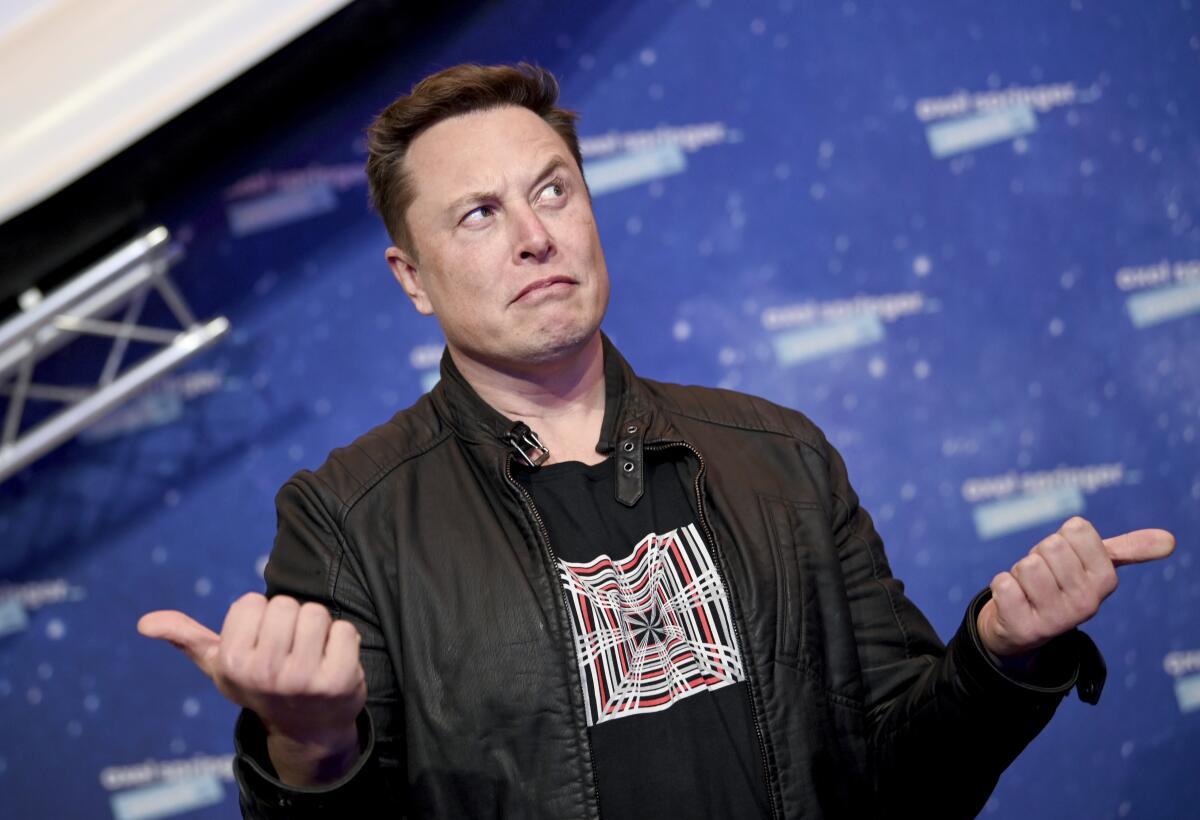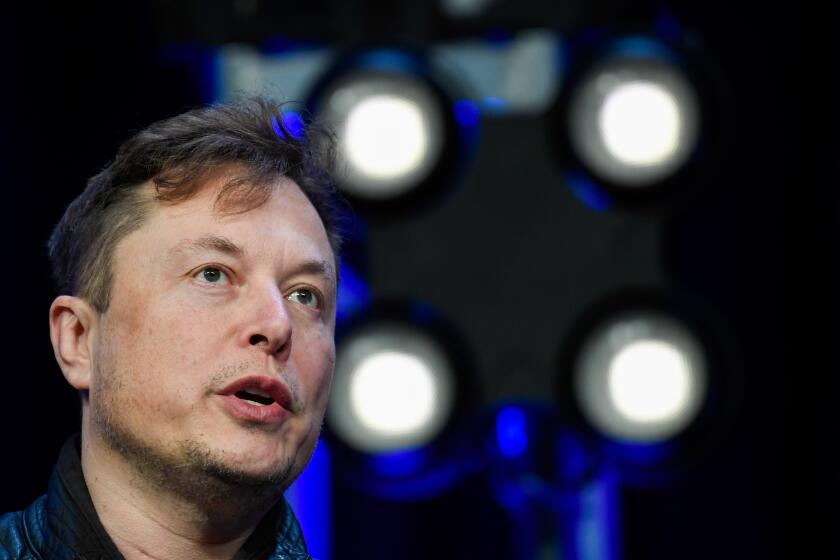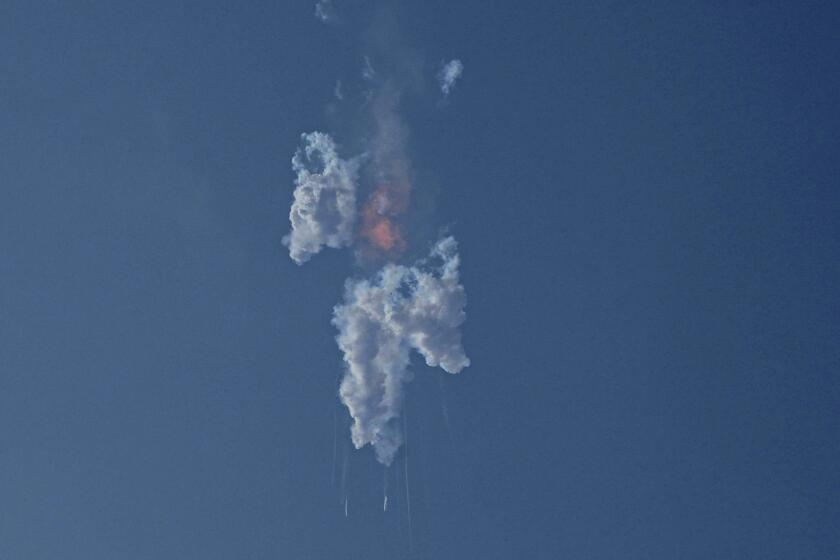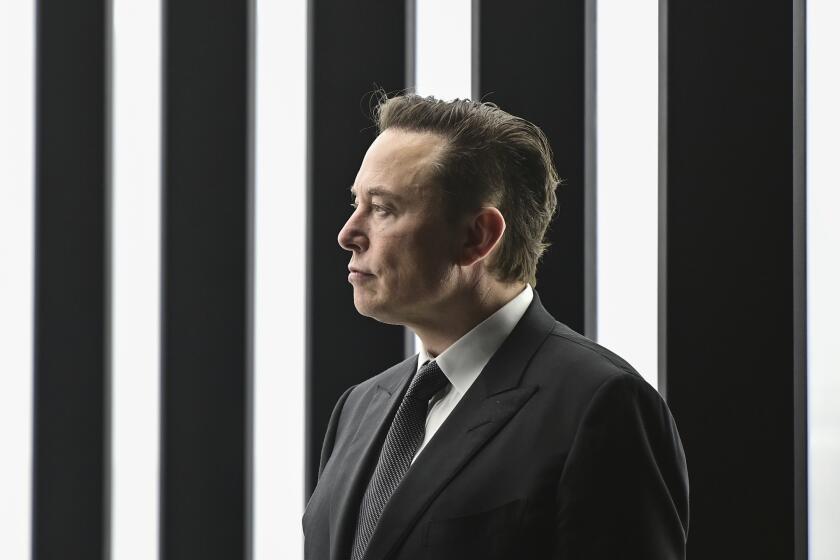Column: A judge voids Musk’s huge Tesla pay package as dishonest, and hoo boy, is Musk steamed

- Share via
Elon Musk may be learning the hard way that his streak of always having things his own way is coming to an end.
The most recent clue was delivered Tuesday by Delaware Chancellor Kathaleen McCormick, who ordered his groundbreaking $56-billion 2018 pay package from Tesla rescinded, dealing a potentially permanent blow to Musk’s reign as the world’s richest man.
If McCormick’s blockbuster 201-page order in the lawsuit brought by a Tesla shareholder survives a likely appeal to the Delaware Supreme Court, Musk would have to give up the options on nearly 304 million shares that the Tesla board awarded him in that 2018 pay deal.
Musk wielded the maximum influence that a manager can wield over a company.
— Delaware Chancellor Kathaleen McCormick
Of those options, 25.3 million are still unvested because their vesting dates haven’t yet been reached. Musk hasn’t yet exercised any of the options that have vested thus far; in McCormick’s view, that makes reversing the pay package a relatively simple matter.
Musk reacted to McCormick’s ruling with characteristic truculence. “Never incorporate your company in the state of Delaware,” he tweeted soon after the ruling was released.
Get the latest from Michael Hiltzik
Commentary on economics and more from a Pulitzer Prize winner.
You may occasionally receive promotional content from the Los Angeles Times.
He then tweeted a poll asking users if Tesla should change its state of incorporation to Texas, its headquarters state. By midday Wednesday, more than 87% of the nearly 1 million respondents voted “yes” (though respondents to Musk’s tweeted polls invariably see things his way).
In responding this way, Musk validated one of McCormick’s points — that his personal interests often have outweighed those of other Tesla shareholders in corporate decision-making. The truth is that most major corporations incorporate in Delaware because its laws and courts are extremely business-friendly.
Musk had encountered McCormick before, perhaps to his enduring regret. It was she who presided over the Chancery Court lawsuit brought by the Twitter board in 2022 to force him to complete his purchase of the social media platform after he attempted to back out.
With a trial of the lawsuit drawing near and McCormick signaling, if subtly, that she wasn’t going to be intimidated by Musk’s usual bluster, he completed the deal in October 2022.
Elon Musk has gone full antisemite, raising questions about the future of his companies and their relationships with commercial and government entities.
Since then, he has sold tens of billions of dollars of his Tesla holdings to shore up the finances of Twitter (now X), even as he drives off advertisers and users through his open embrace on the platform of antisemitism and other varieties of hate speech.
That brings us to McCormick’s ruling on the pay deal. There’s a lot to find fascinating, even entertaining, in a text punctuated with quotations from Shakespeare and “Star Trek.”
The inner workings of corporate management can be opaque to laypersons, but McCormick lays out with admirable clarity how the deal came to pass and why it deserves to be reversed.
Along the way, she raises important questions about how a corporate board should deal with a “superstar CEO” such as Musk, and how to strike the proper balance between the value a chief executive has created for shareholders, and how much of that value should flow back to the CEO. Accomplished CEOs arguably deserve plenty in compensation; the issue is how much plenty is enough, or too much.
A brief outline of the 2018 pay deal is in order.
The Tesla board awarded Musk as much as 12% of Tesla shares over 10 years in 12 blocks, or tranches. Each tranche would vest with each increase in Tesla’s market value of $50 billion and with specified targets of revenue and operating earnings growth. Altogether, the deal was valued at up to $55.8 billion.
The plan’s magnitude was indescribable in conventional executive compensation terms. McCormick called it “the largest potential compensation opportunity ever observed in public markets by multiple orders of magnitude.” It was 250 times larger than median pay packages in comparable corporations, and more than 33 times larger than the closest comparison — which was the previous pay package Tesla had awarded Musk, in 2012.
Scientists came to see Twitter as an indispensable tool for communicating with each other and the public. As X, it’s turned into a source of scientific misinformation and lies.
McCormick concluded, following a five-day trial in 2022, that Musk’s dominating role at Tesla warranted that the board conduct an especially stringent arms-length process to reach a pay settlement. This it did not do.
“Rather than negotiating against Musk,” she writes, the board’s compensation committee “engaged in a ‘cooperative [and] collaborative’ process antithetical to arm’s-length bargaining.... In the end, Musk dictated the Grant’s terms, and the committee effected those wishes.”
That could not have been a surprise, considering the makeup of the committee and the board as a whole. The chair of the committee, board member Ira Ehrenpreis, had invested tens of millions of dollars in Musk companies. He, Musk and Musk’s brother Kimbal (also a Tesla board member) had known one another for 15 years.
Another committee member, board member Antonio Gracias, had a Tesla stake that had grown from $15 million to about $1 billion during Musk’s tenure. His family and Musk’s regularly spent vacations together and his friendships extended to Kimbal and to Musk’s mother and sister.
Among the other board members were James Murdoch, the son of Rupert Murdoch and a personal friend of Musk’s, and Linda Johnson Rice, a personal friend of Gracias’.
The non-director Tesla executives assigned to help craft the pay package tended to see themselves as Musk acolytes or were otherwise “beholden to Musk,” as McCormick describes the atmosphere. One was Tesla general counsel Todd Maron, who was Musk’s former divorce attorney and whose “admiration for Musk moved him to tears” during a pretrial deposition.
At the board level, this was “as close to ... a controlled mindset as it gets,” McCormick writes. But there’s more, pertaining to the question of whether Musk is truly a “controlling” person at Tesla.
As she observes, at the time of the pay negotiations he owned 21.9% of the company shares, mathematically not enough for voting control. But there are other considerations.
Ron DeSantis announced his presidential candidacy via Elon Musk’s Twitter, and it went about as well as you might have expected.
Musk was then Tesla’s chairman, CEO and effectively its founder. (Although the company had been founded by others, it was Musk who after buying into the company in 2004 imposed a vision and strategy that transformed Tesla from a small startup with a single electric vehicle in its product lineup to the leading EV manufacturer in the world, with 100,000 employees as of the end of 2021 and a market value of more than $1 trillion.)
At the time of the pay negotiations, Musk had personal ties to three of the eight active board members (his brother, Gracias and Murdoch). His public renown and record as chair and CEO encouraged the board to believe that Tesla’s very survival depended on keeping Musk on board and placated.
They granted him extraordinary authority without any significant supervision, allowing him to make hiring and firing decisions, approving all financial plans, and unilaterally reassigning Tesla employees to his other companies, such as when he personally sent about 50 Tesla engineers to Twitter to evaluate the latter’s engineering.
And in 2016, when his solar power company SolarCity was floundering, the Tesla board waved through a merger into Tesla that rescued the solar firm’s shareholders at the expense of Tesla’s. Musk sat on both firms’ boards, two of his cousins and Gracias were on the SolarCity board, and Gracias and Brad Buss, a former SolarCity executive, were on Tesla’s board. The merger appeared to be as far from an arm’s-length transaction as human arms could allow.
“Musk wielded the maximum influence that a manager can wield over a company,” McCormick judged.
The board allowed Musk to dominate the design of his pay package as he dominated all other aspects of Tesla management. The board seemed disinclined to use outside guidance in benchmarking Musk’s pay against that of CEOs at comparable companies.
Tesla argued at trial that the pay plan was so much larger than any other in corporate history that it would be impossible to find comparable executives or pay plans. McCormick isn’t having any of that.
Elon Musk is doing his best to drive reasonable Twitter users away by promoting false accusations against Fauci and anti-LGBTQ conspiracy-mongering.
“As CEO, Musk’s job was the same as every other public company CEO: improve earnings and create value.... The extraordinary nature of the Grant should have made benchmarking more critical, not less.” Without that fundamental data, the Tesla board had no idea just how extraordinary it was.
The death blow to the pay package, as McCormick lays it out, is that the Tesla board misled shareholders about its nature and the process that brought it into being.
In its proxy statement for its 2018 annual meeting at which shareholders would be asked to vote on the package, the company stated that all the members of the compensation committee were “independent directors.” That was obviously untrue, given that Ehrenpreis and Gracias held two of its four seats and Ehrenpreis was its chair.
McCormick also noted that the proxy described the milestones that Musk would have to meet to acquire his shares would be “very difficult to achieve.” In fact, the nearer-term milestones fell within the company’s internal financial projections.
Although the two large institutional proxy advisory firms, Glass Lewis and Institutional Shareholder Services, advised their clients to vote against the pay deal — ISS described its magnitude as “staggering” — 73% of shareholders approved the package at a special meeting.
Things haven’t gone as well for Musk and Tesla lately as they appeared in 2018. After topping $1 trillion, the company’s market capitalization is now less than $600 billion. Tesla faces head winds from competition in the EV market from legacy automakers and a consumer shift away from full EVs toward hybrids; these factors have forced Tesla to cut prices sharply, eroding its profit margin. Its shares have lost about 25% so far this year and about 36% since their most recent peak in July.
Musk’s holdings of Tesla have fallen to about 13% from 21.9% in 2008, due largely to his sales of Tesla stock to finance his Twitter deal. If he is able to liquidate his entire 2018 stock grant, that would bring his holdings back to about 22.5%. He recently informed the Tesla board that unless his holdings can be raised to 25%, he would prefer building AI and robotics products, which he has said are in Tesla’s future, “outside of Tesla.”
The fundamental question McCormick poses is why the board thought such an outsized pay grant was necessary to keep Musk at Tesla and focused on its growth. He had repeatedly stated in public that he intended to stay at Tesla to the end of his days.
The board may have been concerned that his other companies, including SpaceX and Twitter, would distract him from his duties at Tesla, but they evidently made no effort to write into the pay package any requirement that he devote a given number of hours exclusively to Tesla.
After all, his 21.9% stake in Tesla should have been enough to give him a powerful incentive to stay in place and maximize the company’s fortunes — every $50-billion increase in Tesla’s market capitalization meant $10 billion more in his pocket.
Notwithstanding his recent threat to take his AI and robotics work elsewhere, wouldn’t he have stayed at Tesla in 2018 even if the board offered him less, or even nothing?
“Was the richest person in the world overpaid?” McCormick asks. That, she writes, is “the $55.8 billion question.”
More to Read
Get the latest from Michael Hiltzik
Commentary on economics and more from a Pulitzer Prize winner.
You may occasionally receive promotional content from the Los Angeles Times.















